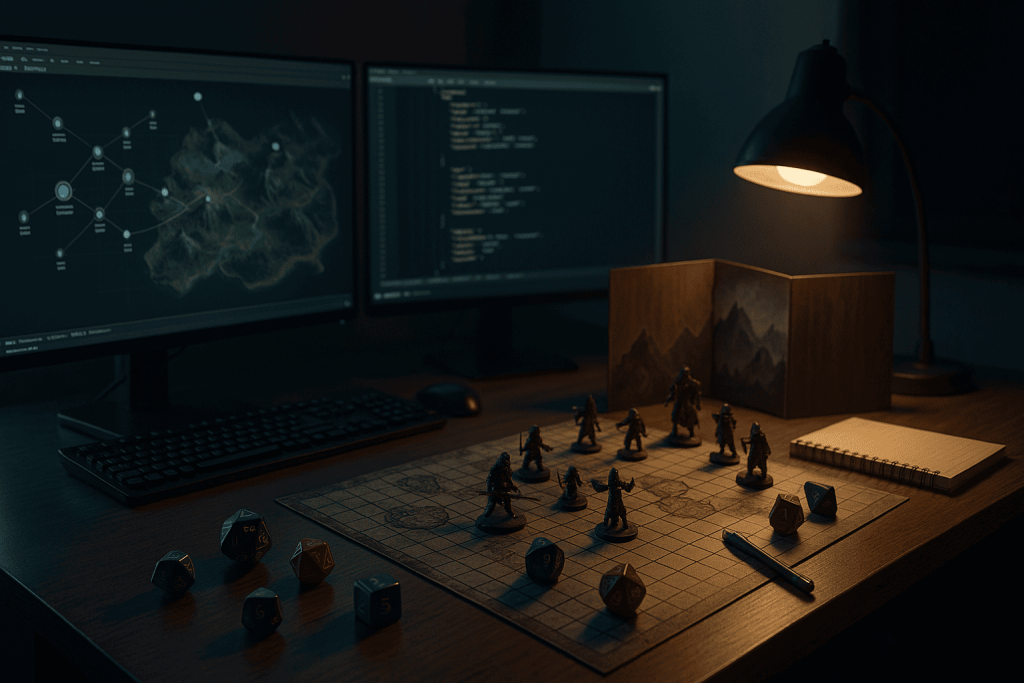Games have always chased the dream of worlds that feel alive. With GPT-class models, that dream moves from scripted illusion to responsive simulation: characters that converse, remember, and change; quests that adapt to the state of the world; and tabletop sessions where an AI can co-GM without stealing the spotlight. This guide shows how to use GPT to build procedural worlds and believable NPCs across the spectrum—from indie tabletop tools to large-scale AAA pipelines—while keeping performance, safety, and player agency front and center.
Why GPT changes the design space
Classic content pipelines scale linearly with headcount: more writers, more quests, more barks. GPT changes the relationship between authoring effort and experiential variety. Designers can author compact contracts (schemas, rules, persona guides) and let the model produce infinite variations that still respect canon. The craft shifts from writing every line to designing generators, guardrails, and evaluation loops that keep outputs coherent, performant, and fun.
Core principle: generation under constraints, never in a vacuum
Unconstrained text is cheap and chaotic. Useful generation is bounded: by world lore, by systems data (time, weather, faction control, resources), and by hard rules (no-breaking-canon, no-spawn-items-you-don’t-own). Feed GPT structured state and explicit contracts, not vibes. The result: content that feels authored, reacts to play, and never contradicts your engine.
World lore as a retrieval pack, not a wall of text
Store lore in small, tagged snippets: locations, factions, customs, timelines, laws, notable NPCs. Before each generation, retrieve only the top-k relevant snippets (plus recency filters like “post-siege era”). This keeps context windows lean and makes the output traceable (“this claim cites Lore#Town_Charter_03”). Designers can then update lore in one place and watch the world adapt everywhere.
Persona files: the DNA of living NPCs
Create compact persona documents for key characters: origin, role, goals, secrets, thresholds (“reveals smuggling route only if loyalty ≥ 60 or after the Harvest Festival”), speaking style (cadence, idioms), hard taboos. Add state keys for dynamic traits (loyalty, fear, debt). At runtime, feed GPT: current scene, last two turns of dialog, top persona fragments, and short-term memory. You get replies that are consistent over hours without pre-authoring a dialog tree.
Memory that lasts: short-term, long-term, and world memory
Use three layers. Short-term: a rolling summary of the current scene (who said what, unresolved intents). Long-term: vectorized memories of salient past events (“Player saved my brother at the quay”). World memory: global facts (the mill burned, mayor resigned). Retrieval pulls the right memories for each turn, so an NPC’s attitude actually evolves and the plot acknowledges earlier deeds.
Dialog that respects systems data
Let GPT see the real game state via function-calling (or table lookups in tabletop): inventory, reputation, time-of-day, faction control, quest flags. The model should ask the engine for facts, not invent them. Pattern: GPT proposes an intent (“offer discount if reputation ≥ 70”), calls get_reputation(player), observes 65, revises intent (“no discount; hint at side job to earn favor”). This is how you keep role-play grounded.
Quest generation as contracts, not prose
Design a JSON schema for quests so content plugs directly into gameplay: {objective, location, antagonist, ally, preconditions[], steps[], twist?, reward, fail_state}. Tell GPT to only return valid JSON. Validate and repair on the server; reject on failure. The engine then maps “location=East Docks” and “precondition=night” into navigation goals, schedules, and encounters. Writers review and pin great variants to become canon beats.
Event weaving: keeping the plot reactive
When the world changes, questlines should ripple. Feed GPT a small “delta digest” (town on fire, power outage, festival cancelled). Ask for three scene hooks that integrate the change without derailing the arc (“fire refugees need escort,” “rival exploits chaos”). Designers choose, the engine spawns, and the story feels authored but agile.
AAA-scale performance: hybrid small+big models
Latency and cost matter at scale. Use a small on-device or on-server-fast model for short, frequent lines (ambient barks, merchant chatter, quick acknowledgments). Route complex beats (branching persuasion, lore exposition) to a larger model sparingly. Pre-bake common variants offline and cache per-region/per-faction to keep hot paths snappy. Stream token-by-token so players never stare at a silent NPC.
Tabletop co-GMs: respectful, rules-aware, and audit-friendly
At the table, GPT should serve the human GM or fill in when there is none—never override player agency. Give it a rules digest, safety tools, and a campaign primer. Ask it to propose scenes, motives, and consequences, roll dice via a visible tool, and keep a session log. Players should be able to audit outcomes (“why DC 15?”) and veto or steer tone at any time.
Moderation, tone, and age appropriateness
Games are social spaces. Always layer content filters and allow-lists on top of GPT outputs. Scope retrieval to age-appropriate lore. Add refusal policies (“deflect harassment; report if repeated”). Surface speculation (“I might be wrong”) rather than bluffing. Players deserve consistent tone; your moderation pipeline keeps the studio’s voice and values intact.
Designing the conversational turn
Each turn should advance play. Pattern: acknowledge → relevant fact → actionable next step. Example: “You did save my brother. I can’t waive the tariff, but meet me after dusk by the warehouse.” Short, grounded, with a hook. Ask GPT to keep replies ≤ 40 words unless the player explicitly asks for detail.
Multi-agent scenes: NPCs that argue, ally, and scheme
Give key NPCs separate persona files and let them “debate” for a bounded number of turns to reach a stance before speaking to the player. A lightweight coordinator sets goals and resolves conflicts (“guard captain prioritizes order; smuggler prioritizes profit”). You get party banter, faction politics, and emergent alliances without hard scripting—just keep turn budgets tight for performance.
Behavior trees + GPT: brains and mouths
Do not throw away classic AI. Keep deterministic systems for positioning, cover, stealth, and cooldowns. Use GPT to generate reasons and lines that explain behaviors (“Flanking left—cover me!”). When tactical AI chooses a move, pass a compact action summary to GPT to narrate or justify. The result feels intelligent without risking core combat logic.
Prompt & schema patterns you can copy
Persona template: “You are Marla Voss, sardonic smuggler from Port Halcyon. Goals: clear debt, protect crew, avoid corporate security. Reveals illegal routes only if loyalty ≥ 60 or if the player saved your life. Style: clipped sentences, dry humor. Hard taboos: never betray crew.”
Quest contract: “Return JSON: {objective, location, antagonist, ally, steps[{action, actor, risk}], twist?, reward, fail_state}. Use only locations in <lore>…</lore>. If constraints conflict, ask one clarifying question instead of guessing.”
Dialog guard: “Base replies on <facts>…</facts>. If a needed fact is missing, request it via tool: get_price(item), get_reputation(player). Keep replies ≤ 40 words unless asked for detail.”
Testing and telemetry: prompts are code
Version system prompts and schemas. Build a small suite of “gold dialogs” and quest payloads; run them after every change. In live ops, track token cost, latency, refusal rate, tone drift, and player sentiment. Flag regressions and roll back fast. Treat GPT like a subsystem with observability and ownership, not a black box.
Live ops knobs: update worlds without patching binaries
Keep persona files, lore packs, and prompt versions server-side. You can rotate seasonal events, update faction politics, or hotfix a broken hint without shipping a client patch. Designers ship narrative like live content; players feel the world breathe week to week.
Cost control that doesn’t hurt quality
Cache embeddings and common outputs per region/faction. Batch low-stakes generations (e.g., generating 20 shop rumors at once) and store them. Route easy lines to a cheaper model; escalate only when a confidence threshold or schema complexity requires it. Summarize long contexts before reasoning. Set per-session budgets with graceful degradation (“fallback to stock bark if budget exhausted”).
Indie and modding: big feel, small team
Indies can ship cozy towns with dozens of believable NPCs by combining shared archetypes (shopkeeper, dockhand, herbalist) with per-NPC memories. Expose safe prompt slots to modders—lorebooks, persona patches, seasonal packs—validated by your contracts. You get community creativity without breaking your systems.
Tabletop toolkit: quick starts you can run tonight
Bring a two-page rules digest, a safety checklist, and a setting seed (three factions, two conflicts, one mystery). Ask GPT for three openers and pick one. Keep a visible “truths” list on a card and add new truths as you play. Let the model suggest consequences and voices; you adjudicate rolls and pacing. The game feels hand-crafted, not railroady.
Ethical guardrails: consent, disclosure, and player agency
Disclose when AI is used, especially in social spaces. Offer opt-outs for voice cloning or content personalization. Never trap players in dialog that hides the big choice; always present clear outs. AI should widen choices, not fake them. If a scene demands precision or sensitivity, switch to authored beats.
Common pitfalls (and fast fixes)
Wall-of-text replies: Cap words; push detail to “Ask for more.”
Hallucinated facts: Require tool calls/retrieval for anything factual; if missing, ask, don’t invent.
Flat NPCs: Add goals, thresholds, and secrets to persona; retrieve one long-term memory per turn.
Performance pain: Pre-bake variations, route trivial lines to a small model, stream responses.
Tone drift: Include style rules and one gold example line in every request; run a post-generation tone check.
A minimal end-to-end loop (copy this)
On player approach → retrieve persona + 2–3 relevant lore/memory snippets → call small model for greeting under 25 words → if player engages in negotiation/persuasion, escalate to larger model with function-calls for reputation/inventory → return a compact reply + next-step hook → log memory (“owed favor +10”). This loop alone turns static merchants into characters players remember.
What’s next: multimodal, multi-agent, and more diegetic UI
Expect NPCs that read the scene (map tiles, lighting, player emotes), coordinate in squads, and keep grudges across campaigns. Expect diegetic interfaces—radios, grimoires, terminals—where “typing to an NPC” feels like play, not UI. As models get better at grounding and small models keep shrinking latency, living worlds will feel normal rather than novel.
Conclusion
From tabletop to AAA, GPT lets you trade exhaustive scripting for generative systems that listen, remember, and adapt. The craft is constraint: schemas, persona rules, retrieval, tool calls, and tests that keep creativity inside the rails of your world. Do that, and NPCs stop being quest dispensers and start being people; worlds stop being backdrops and start being partners in play. The technology is ready. The design patterns are here. The next unforgettable encounter in your game can be generated—on purpose.


